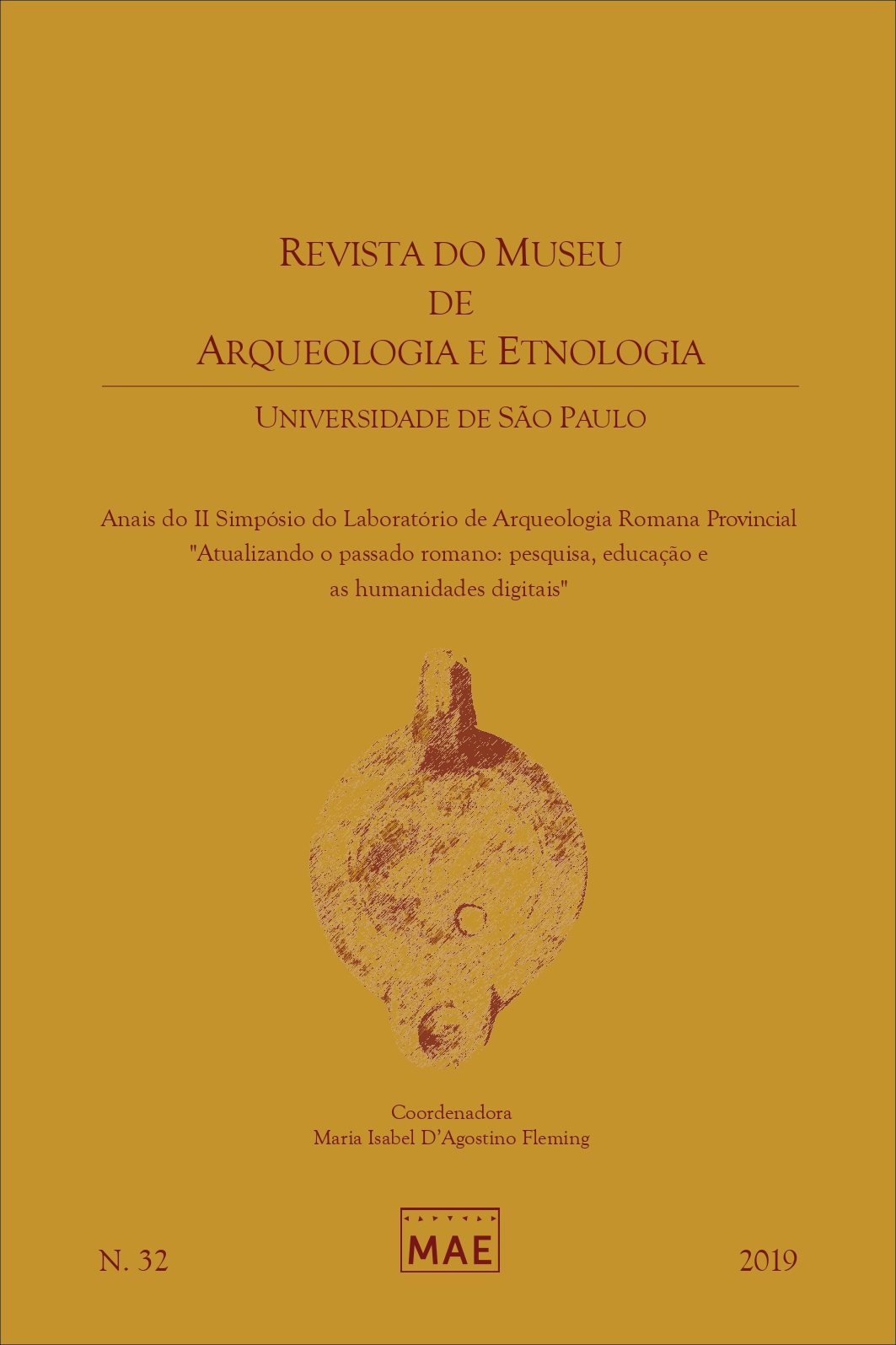Fear and fury in the streets of town: the government of Gallus Caesar at Antioch (351-354 AD)
DOI:
https://doi.org/10.11606/issn.2448-1750.revmae.2019.164176Keywords:
Late Antiquity, Antioch, Space, Gallus Caesar, Ancient RomeAbstract
Being a familiar space to the passers-by, the streets of a town are frequently converted into a dangerous, hostile, threatening space due to the frequency and intensity of the violent acts that they support and the surveillance which tries to control the daily routine of the social agents, catching them in a net of micro powers that often spreads from the public space and reaches even the private houses. In Late Antiquity, an episode seems to illustrate this possibility of converting the town and its streets into a notable support for the discretionary deployment of power through violence and conflict. We mention here the sojourn of Gallus Caesar at Antioch between 351 and 354 AD, when the metropolis of the Syrian province was governed by a ruler who, in order to consolidate his position, did not hesitate to put at risk the urban order.
Downloads
References
Ammianus Marcellinus. 1950. History. Translated by John C. Rolfe. Harvard University Press, Cambridge.
Aurelius Victor. 1975. Livre des Césars. Texte établi et traduit par Pierre Dufraigne. Les Belles Lettres, Paris.
Benoist, S. 1997. L’espace urbain de Rome, comme lieu d’encadrement de la foule au premier siècle de l’Empire. In: Leménorel, A. (Éd.) La rue, lieu de sociabilité? Publications de l’Université de Rouen, Rouen: 215-223.
Bijovsky, G. 2007. Evidence for the Gallus revolt: the hoard from Lod. Israel Exploration Journal, v. 57, n. 2: 187-203.
Blockley, R. C. 1972. Gallus and Julian as Caesars of Constantius II. Latomus, t. 31, fasc. 2 : 433-468.
Cabouret, B. 1999. Sous les portiques d’Antioche. Syria, t. 76: 127-150.
Crawford, P. 2016. Constantius II: usurpers, eunuchs and the Antichrist. Pen & Sword, Barnsley.
Downey, G. 1961. A history of Antioch in Syria. Princeton University Press, Princeton.
Drake, H. 2002. Constantine and the bishops. The John Hopkins University Press, Baltimore.
Eutrope. s/d. Abrégé de l’Histoire Romaine. Traduit par M. N. A. Dubois. Garnier, Paris.
Gebhard, E. R. 1999. The theater and the city. In: Slater, W. (Ed.) Roman theater and society. The University Michigan Press, Ann Arbor: 113-127.
Gonçalves, A. T. M. 2013. A noção de propaganda e sua aplicação nos Estudos Clássicos: o caso dos imperadores romanos Septímio Severo e Caracala. Paco, Jundiaí.
Guglielmi, N. 1997. La rue, espace polysémique. In: Leménorel, A. (Éd.) La rue, lieu de sociabilité? Publications de l’Université de Rouen, Rouen: 87-93.
Hodder, I. 1994. Architecture and meaning: the example of Neolithic houses and tombs. In: Pearson, M. P.; Richards, C. (Ed.) Architecture and order. Routledge, London: 73-86.
Juliano. 1979. Al senado y al pueblo di Atenas. In: Juliano. Discursos I-V. Introducción, traducción y notas de José García Blanco. Gredos, Madrid: 303-339.
Kaiser, A. 2011. Roman urban street networks. Routledge, London.
Leménorel, A. 1997. Rue et perception politique. In: Leménorel, A. (Éd.) La rue, lieu de sociabilité? Publications de l’Université de Rouen, Rouen: 253-259.
Libanio. 2001. Autobiografia (Discurso I). Introducción, traducción y notas de Antonio Melero Bellido. Gredos, Madrid.
Libanius. 1969. Funeral oration over Julian (Or. XVIII). In: Libanius. Selected orations. Translated by A. F. Norman. Harvard University Press, Cambridge. V. I: 278-487.
Libanius. 1977. To the emperor Theodosius about the riots (Or. XIX). In: Libanius. Selected orations. Translated by A. F. Norman. Harvard University Press, Cambridge. V. II: 268-309.
Liebeschuetz, J. H. W. G. 1972. Antioch, city and imperial administration in the Later Roman Empire. Clarendon Press, Oxford.
Lynch, K. 2006. L’immagine della città. Marsilio, Venezia.
Petit, P. 1955. Libanius et la vie municipale a Antioche au IVe Siècle aprés J.-C. Paul Geuthner, Paris.
Philostorgius. 2007. Church History. Translated with an introduction and notes by Philip R. Amidon. Society of Biblical Literature, Atlanta.
Ross, A. J. 2016. Ammianus’ Julian: narrative and genre in the Res Gestae. Oxford University Press, Oxford.
Saliou, C. 2011. Jouir sans entraves? La notion de tryphè dans l’Éloge d'Antioche de Libanios. In: Lagacherie, O.; Malosse, P. L. (Éds.) Libanios, le premier humaniste. Edizioni dell’Orso, Alessan¬dria: 153-165.
Silva, G. V. 2003. Reis, santos e feiticeiros: Constâncio II e os fundamentos místicos da basileia. Edufes, Vitória.
Silva, G. V. 2007. História, verdade e justiça em Amiano Marcelino. In: Joly, F. (Org.) História e retórica: ensaios sobre historiografia antiga. Alameda, São Paulo: 166-182.
Silva, G. V. 2013. Espaço, cotidiano e sociabilidades em Antioquia: uma leitura do Antiochikos, de Libânio. In: Cerqueira, F.; Gonçalves, A. T.; Medeiros, E.; Delfim, L. (Orgs.) Saberes e poderes no Mundo Antigo. Impressa da Universidade de Coimbra, Coimbra. V. 1: 257-274.
Silva, G. V. 2015. Juliano e a imagem de Antioquia no Misopogon. In: Silva, G. V.; Silva, E. C. M. (Orgs.). Fronteiras e identidades no Império Romano: aspectos sociopolíticos e religiosos. GM Editora, Vitória: 119-140.
Socrates. 2004. The ecclesiastical history. In: Schaff, P.; Wace, H. (Eds.) Nicene and post-Nicene fathers. Text translated by A. C. Zenos. Hendrickson, Peabody. V. 2: 1-178.
Sozomenus. 2004. The ecclesiastical history. In: Schaff, P.; Wace, H. (Eds.) Nicene and post-Nicene fathers. Text translated by Chester D. Hartranfty. Hendrickson, Peabody. V.2: 181-427.
Thompson, E. A. 1943. Ammianus’ account of Gallus Caesar. The American Journal of Philology, v. 64, n. 3: 302-315.
Vogler, C. 1979. Constance II et l’administration impé¬riale. AECR, Strasbourg.
Weber, M. 1986. As causas sociais do declínio da cultura antiga. In: Cohn, G. (Org.) Weber. São Paulo: Ática, p. 37-57.
Zonaras. 2009. The history of Zonaras: from Alexander Severus to the death of Theodosius the Great. Translation by Thomas. M. Banchich and Eugene N. Lane. Routledge, London.
Downloads
Published
Issue
Section
License
Copyright (c) 2019 Gilvan Ventura da Silva

This work is licensed under a Creative Commons Attribution-NonCommercial-NoDerivatives 4.0 International License.













